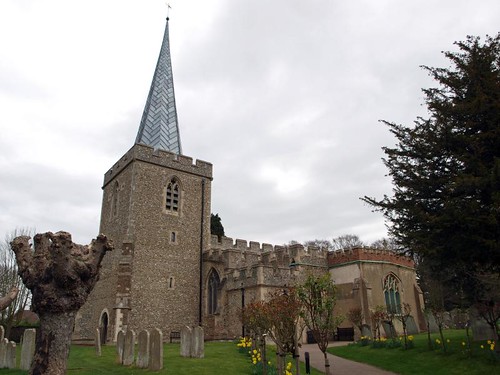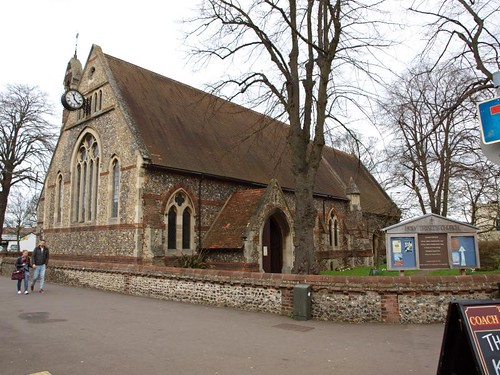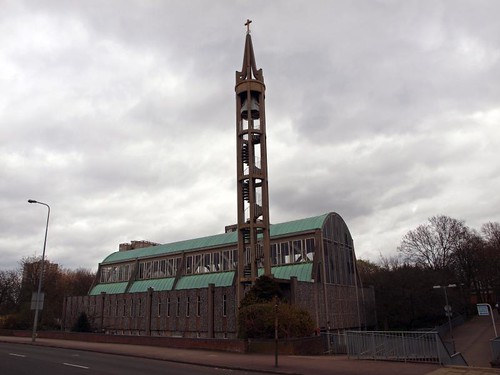St Nicholas was firmly lnk, although I could hear someone hoovering inside they plainly did not hear me rattling doors, which is a pity as it sounds interesting even if the interior is as overly restored as the exterior.
Holy Trinity is a very bland 1861 Blomfield creation but deserves bonus points for being open
SS Andrew & George is without doubt the ugliest church, and quite possibly building, I've ever laid eyes on but once inside I rather liked the light and air space; just ignore the feeling that you're in a prototype Stansted Airport.
ST NICHOLAS. Away from the town to the NE, almost entirely on its own. A flint church with a low W tower with leaded spire. The upper parts and the diagonal brick buttresses are C15, but the tower itself (see its windows and W door) is Norman. The S view of the church is specially rewarding with the various steps in height and in depth. The church is entirely embattled. S porch at the W end of S aisle, S transept added 1841. Most of the windows point to the C14 (chancel N and S; chancel chapels E but with early C14 tracery; N chancel chapel N; odd windows in the aisles). The arcades between chancel and chapels are of the early C14 too. Those in the nave are C15 on C13 bases and shafts. The clerestory and the nave and chancel roofs are also C15. The niche for a statue in the NE corner of the N chapel may be C14 or c15. - FONT. Plain C13, with later ogee-shaped cover. - SCREENS. Complete set of screens between nave and chancel, aisles and chapels, and also chancel and chapels, the latter as usual more modest, but the principal ones also by no means as lavish as those of East Anglia. - CHOIR Seats, C15, with MISERICORDS (mostly leaves; also an angel with spreadout wings, and a face with leaves growing out of the mouth). - STAINED GLASS. E window, 1842, S chancel window, 1848, both supposed to be by Wailes (TK); but can they be by the same artist? The E window has four saints, with canopies, in traditional colours. The S window is a three-light Noli me tangere in gaudy colours (still the painterly approach of the C18 and by no means yet medievalizing). - PLATE. Chalice and Paten, 1634; Flagon and Paten, 1683. - MONUMENTS. Brass to Stephen Hillard, c. 1500, largish figure of a priest in vestments. - Mutilated effigy of a lady wearing a wimple; an angel and a priest by her pillow; c. 1300.
HOLY TRINITY, 1861, by Blomfield. An early church of his, before his style became smooth and competent and stale. Nave and chancel only, with a bellcote. Flint with stone, red brick, and white brick adornments. Tiled roof with bands of fancy tiles. Plate tracery. A new larger nave and chancel were added by Tate & Popplewell in 1881-5, ‘and a very good match they made’ (GR).
Stevenage. It lies on the Great North Road which widens as it passess by the six little hills which set every motorist wondering. How ol they are no man knows, but, Danish, Roman, or Celtic, they were built up here as burial mounds and remain as the town’s chief monument, the six hills from which the Saxons named it Stevenage, meaning Hills by the Highway. There are inns from the coaching days which seem young compared with the six graves, but at one of them, the Swan, the first Earl of Minto died in 1814. on his way home after a vigorous rule of India as Governor-General. At one end of the town is the grammar school founded by Thomas Alleyn in 1558. It has, of course, grown greatly, but has one of its oldest buildings still in use. At the other end of the town, near the new church, is a timbered building 400 years old which is now used as offices. The main street is bordered with picturesque houses and inns, and any boy you meet in it will tell you that it is the highest street between London and York. We must leave them to settle it with the boys of St Albans.
Since this book was first written great changes have occurred at Stevenage, and the little town has grown into a sizeable city of 50,000 inhabitants and is still expanding. This rapid growth has, of course, involved the loss of much good farmland and quiet scenic beauty.
A fine avenue of limes and chestnuts leads to where the 15th-century spire of the old church rises on a hill, with but a remnant round it of the village which moved down the hill after a fire. The church is Norman and medieval, the Norman tower with little Norman windows remaining after 800 years. The nave arcades have 15th-century arches on 13th-century pillars, and the chancel arcades are 14th century, so that we have Norman work and the work of our three great building centuries. Above the tower arch is an opening made by the Normans which led into their nave roof, and from the outside we may see another opening made to lead into a roof 600 years ago. There are ancient wooden corbels supporting the nave roof, and stone angels supporting the chancel beams. The 13th-century font has an ancient cover still touched with colour. There are six stalls with misericords carved about 1400, and four screens with handsome 15th-century woodwork in them.
In one corner of the church is the broken stone figure of a woman in 13th-century dress, a priest and an angel supporting her, so that she must have been a great lady, though not too great to have been used for generations as a stone in the floor, face downwards. On a brass of 1500 is the portrait of the rector, Stephen Hellard, in his canon’s cope.
Since this book was first written great changes have occurred at Stevenage, and the little town has grown into a sizeable city of 50,000 inhabitants and is still expanding. This rapid growth has, of course, involved the loss of much good farmland and quiet scenic beauty.
A fine avenue of limes and chestnuts leads to where the 15th-century spire of the old church rises on a hill, with but a remnant round it of the village which moved down the hill after a fire. The church is Norman and medieval, the Norman tower with little Norman windows remaining after 800 years. The nave arcades have 15th-century arches on 13th-century pillars, and the chancel arcades are 14th century, so that we have Norman work and the work of our three great building centuries. Above the tower arch is an opening made by the Normans which led into their nave roof, and from the outside we may see another opening made to lead into a roof 600 years ago. There are ancient wooden corbels supporting the nave roof, and stone angels supporting the chancel beams. The 13th-century font has an ancient cover still touched with colour. There are six stalls with misericords carved about 1400, and four screens with handsome 15th-century woodwork in them.
In one corner of the church is the broken stone figure of a woman in 13th-century dress, a priest and an angel supporting her, so that she must have been a great lady, though not too great to have been used for generations as a stone in the floor, face downwards. On a brass of 1500 is the portrait of the rector, Stephen Hellard, in his canon’s cope.



No comments:
Post a Comment